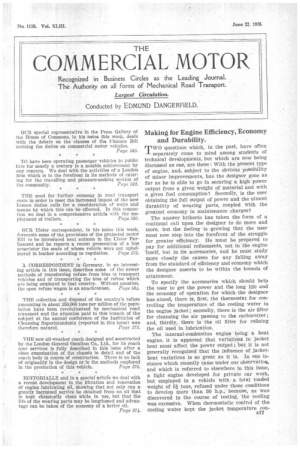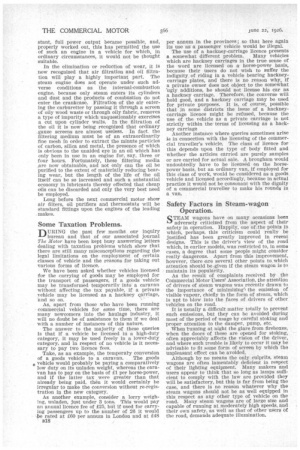Making for Engine Efficiency, Economy and Durability.
Page 1

Page 2

If you've noticed an error in this article please click here to report it so we can fix it.
T" questions which, in the past, have often separately come to mind among students of technical developments, but which are now being discussed as one, are these: With the present type of engine, and, subject to the obvious possibility of minor improvements, has the designer gone as far as he is able to go in securing a high power output from a given weight of material and with a given fuel consumption? Secondly, is the user obtaining the full output of power and the utmost durability of wearing parts, coupled with the greatest economy in maintenance charges?
The ansWer hitherto has taken the form of a continual call upon the designer to do more and more, but the feeling is growing that the user must now step into the forefront of the struggle for greater efficiency. He must be prepared to pay for additional refinements, not in the engine 'Itself, but in its accessories, and he must study more closely the causes for any falling away from the standard of efficiency and economy which the designer asserts to be within the bounds of attainment.
To specify the accessories which should help the user to get the power and the long life and the economy of operation for which the designer has aimed, there is, first, the thermostat for controlling the temperature of the cooling water in the engine jacket; secondly, there is the air filter for cleansing the air passing to the carburetter ; and, thirdly, there is the oil filter for• refining the oil used in lubrication.
The internal-combustion engine being a heat engine, it is apparent that variations in jacket heat must affect the power output; but it is not generally recognized that the influence of jacketheat variations is so great as it is. In one instance which recently came under our observatio*, and which is referred to elsewhere in this issue, a light engine developed for private ear work, but employed in a vehiclewith a total loaded weight of 5/ tons, refused under those conditions to develop more than 30 b.p., because, as was discovered in the course of testing, the 'cooling was excessive. When thermostatic control of the cooling water kept the jacket temperature con stant, full power output became possible, and, properly worked out, this has permitted the use of such an engine in a vehicle for which, in ordinary circumstances, it would not be thought suitable.
In the elimination or reduction of wear, it is now recognized that air filtration and oil filtration will play a highly important part. The steam engine does not operate under such adverse conditions as the internal-combustion engine, because only steam enters its cylinders and dust and the products of combustion do not enter the crankcase. Filtration of the air entering the carburetter by passing it through a screen of oily wood waste or through oily fabric, removes a type of impurity which unquestionably exercises a cut upon cylinder walls. In the filtration of the oil it is now being recognized that ordinary gauze screens are almost useless. In fact. the filtering medium must be of an extraordinarily line mesh in order to extract the minute particles of carbon, silica and metal, the presence of which is obvious to the unaided eye in an oil which has only been in use in an engine for, say, three or four hours. Fortunately, these filtering media are now obtainable, and not only can the oil be purified to the extent of materially reducing bearing wear, but the length of the life of the oil itself can be so increased and such a substantial economy in lubricants thereby effected that cheap oils can be discarded and only the very best need be employed.
Long before the next commercial motor show air filters, oil purifiers and thermostats will be standard fittings upon the engines of the leading • makes.
Some Taxation Problems.
JJTIRING the past few months our inquiry bureau and that of our associated journal The Motor have been kept busy answering letters dealing with taxation problems which show that there are still many misconceptions regarding the legal limitations on the employment of certain classes of vehicle and the reasons for taking out various forms of licence.
We have been asked whether vehicles licensed for the carrying of goods may be employed for the transport of passengers, if a goods vehicle may be transformed temporarily into a caravan without affecting the tax payable, if a private vehicle may be licensed as a hackney carriage, and so on.
As, apart from those who have been running commercial vehicles for some time, there are many newcomers into the haulage industry, it will no doubt be of assistance to them if we deal with a number of instances of this nature.
The answer to the majority of these queries Is that if a vehicle be licensed in a high-duty category, it may be used freely in a lower-duty category, and in respect of no vehicle is it necessary to pay two licence fees.
Take, as an example, the temporary conversion of a goods vehicle to a caravan. The goods • vehicle would probably be paying a comparatively low duty on its unladen weight, whereas the caravan has to pay on the basis of £1 per horse-power, and if the latter tax were greater than that already being paid, then it would certainly be Irregular to make the conversion without re-registration in the new category.
As another example, consider a lorry weighing, unladen, just under 3 tons. This would pay an annual licence fee of £25, but if used for carrying passengers up to the number of 26 it would be rated at 160 per annum in London and at 148 • B18 per annum in the provinces; so that here again its use as a passenger vehicle would be illegal. The use of a hackney-carriage licence presents a somewhat different problem. Many vehicles which are hackney carriages in the true sense of the word are licensed on a horse-power basis, because their users do not wish to suffer the indignity, of riding in a vehicle bearing hackneycarriage plates, and there is no reason why, if a private owner does not object to the somewhat 'ugly additions, he should not license his car as a hackney carriage. Therefore, the converse will hold good, and a hackney carriage may be used for private purposes. It is, of course, possible that In some districts the issue of a hackneycarriage licence might be refused, because the use of the vehicle as a private carriage is not strictly within the terms of licensing as a hackney carriage Another instance where queries sometimes arise is in connection with the licensing of the commercial traveller's vehicle. The class of licence for this depends upon the type of body fitted and whether the articles carried are purely samples or are carried for actual sale. A brougham would undoubtedly have to be licensed on the horsepower basis, but an ordinary van, if employed for this class of work, would be considered as a goods vehicle and licensed accordingly, because in actual practice it would not be consonant with the dignity of a commercial traveller to make his rounds in a van.






























